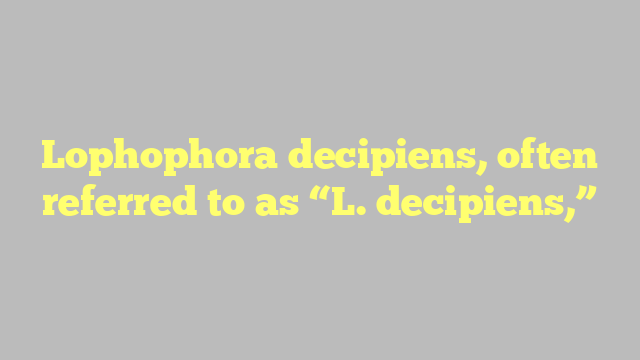“L. decipiens,” is a term commonly used in the peyote community to describe a specific growth form of the Lophophora cactus genus. However, it is important to note that L. decipiens is not a recognized botanical species or variety of Lophophora. Instead, it is a term used to describe certain plants with unique growth patterns.
The name “decipiens” originates from a drawing of a cactus with interesting tubercles, or small rounded projections, made by Croizat in the 1920s. This drawing was based on a specimen of Lophophora fricii, a closely related species. Over time, enthusiasts and collectors started using the term “L. decipiens” to describe cacti that resemble the depicted specimen.
Lophophora cacti are known for their small, round, and spine-covered bodies. However, L. decipiens plants deviate from the typical ribbed appearance and instead grow in a tuberculate form, with small, rounded bumps covering the surface of the cactus. This growth pattern gives the plants a distinct and unique appearance compared to other members of the Lophophora genus.
While L. decipiens may not be a recognized botanical name, it has gained popularity in the peyote community due to its reputation for fast growth and larger cactus bodies. Some individuals claim that L. decipiens plants have equal or higher alkaloid content than the more common Lophophora williamsii, which is known for its psychoactive compound, mescaline.
However, it is important to approach these claims with caution, as there is limited scientific research on L. decipiens specifically. Additionally, the alkaloid content in Lophophora cacti can vary greatly depending on various factors such as genetics, growing conditions, and age of the plant.
It’s worth noting that if you come across seeds or plants labeled as L. decipiens, they are likely Lophophora fricii or another species exhibiting a tuberculate growth form. While these plants may not have the same cultural or historical significance as true Lophophora williamsii, they can still be fascinating and beautiful additions to a cactus collection.
In conclusion, Lophophora decipiens is a term used to describe a specific growth pattern exhibited by certain cacti within the Lophophora genus. While not an officially recognized species or variety, plants labeled as L. decipiens typically display tuberculate growth forms. Whether you are a cactus enthusiast or seeking a peyote-like experience, it’s important to research and understand the specific characteristics and properties of the plants you are working with.
